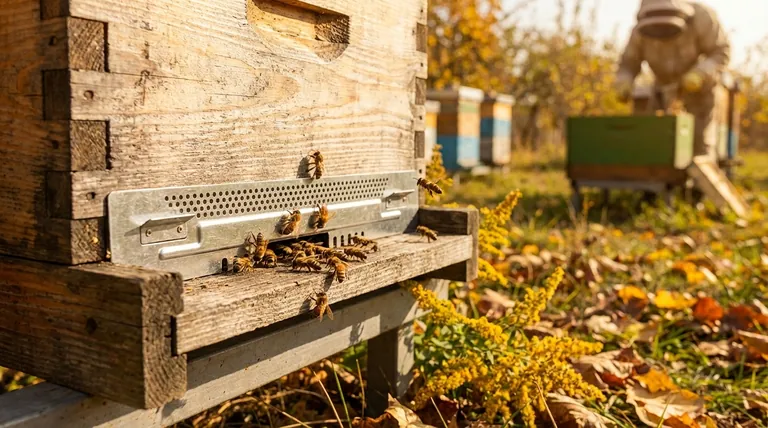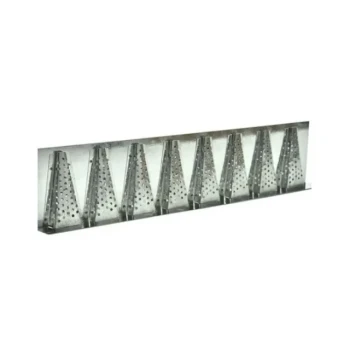In short, the size of the hive entrance is one of the most critical factors in ventilation because it dictates the level of control the bees have over their internal environment. Rather than simply providing maximum airflow, a properly sized entrance allows the colony to create a manageable system for regulating temperature and humidity, adapting to changing seasons and weather conditions.
The core principle is that a smaller, more defensible entrance empowers the bees to efficiently manage their own ventilation. It transforms a wide-open drafty space into a controlled climate system they can precisely regulate through fanning.

The Physics of Hive Air Circulation
A beehive is not a passive structure; it's an active climate-controlled superorganism. The bees themselves are the engine of ventilation, and the entrance is their primary control valve.
How Bees Create Airflow
Honeybees ventilate their hive by fanning their wings. This coordinated effort creates a convection current, pulling fresh, cooler air in one side of the entrance and expelling warm, stale, moisture-laden air out the other side.
The Importance of a Defined "In" and "Out"
A large, wide-open entrance makes this system highly inefficient. It's like trying to cool a house by opening every single window and door; you create unpredictable drafts but have no directed airflow.
A smaller, well-defined entrance allows the bees to create a focused inlet and outlet. This enables them to establish a powerful and consistent current, maximizing the efficiency of their fanning efforts.
Seasonal Demands on Ventilation
The colony's ventilation needs change dramatically between summer and winter, and the entrance size must be adjusted accordingly.
Summer: The Goal is Cooling
During hot weather, the primary ventilation goal is to prevent overheating and to dehydrate nectar into honey. A moderately sized entrance is large enough to prevent a "traffic jam" of foraging bees but small enough for the bees to effectively fan out hot air.
Winter: The Goal is Moisture Control and Heat Retention
In winter, the challenge is twofold: retain heat and expel moisture. A bee cluster generates metabolic moisture, and if it condenses inside the hive, it can be fatal.
A small winter entrance is crucial. It dramatically reduces heat loss while still providing a small opening for the bees to push out the damp air, preventing it from condensing into water droplets above their cluster.
Understanding the Trade-offs
Managing the entrance size is a balancing act. Both extremes present significant risks to the colony.
The Risks of an Entrance That's Too Large
A wide-open entrance leaves a colony vulnerable. In winter, it leads to excessive heat loss, forcing the bees to consume more resources to stay warm. Year-round, it makes the hive much more difficult to defend from robbing bees and pests like wasps.
The Dangers of an Entrance That's Too Small
An overly restricted entrance can be just as damaging. In a summer heatwave, it can prevent the bees from moving enough air, leading to overheating and melted beeswax. It can also create a bottleneck for foragers, reducing the colony's productivity.
Managing Your Entrance for a Healthy Hive
Your role as the beekeeper is to provide an entrance size that is appropriate for the season and the strength of the colony.
- If your primary focus is winter survival: Use an entrance reducer to create a small opening (typically 1-2 inches wide) to conserve heat and allow for moisture management.
- If your primary focus is maximizing summer honey production: Ensure the entrance is large enough to accommodate heavy forager traffic but still defensible for the colony's population size.
- If you are managing a new or weak colony: Keep the entrance reduced year-round to give the smaller population a defensible space they can effectively manage.
By actively managing the hive entrance, you empower your bees to successfully regulate their own environment for year-round health and productivity.
Summary Table:
| Entrance Size | Primary Benefit | Key Risk |
|---|---|---|
| Small | Excellent heat retention & defensibility | Can overheat in summer, foraging bottleneck |
| Large | Maximum forager traffic, good summer cooling | Difficult to defend, excessive winter heat loss |
| Managed (Seasonal) | Optimal balance of climate control & productivity | Requires active beekeeper intervention |
Equip your apiary for superior hive health and honey production. Proper ventilation starts with the right equipment. HONESTBEE supplies durable, well-designed beekeeping supplies and equipment to commercial apiaries and distributors through our wholesale-focused operations. Let us help you optimize your hives for every season. Contact our experts today to discuss your needs and request a wholesale catalog.
Visual Guide

Related Products
- Beehive Entrance Reducer Guardian Metal Hive Entrance for Bees
- Multi-Functional Sliding Hive Entrance for Beekeeping
- Steel Round Disc Entrance Reducer for Flexzion Bee Hive Nuc Box Gate
- Professional Reversible Beehive Hive Entrance
- Multi-Functional Rotary Hive Entrance Disc for Beekeeping
People Also Ask
- What are the different types of entrance reducers available? A Guide to Protecting Your Hive
- What are the features of the side with oblong holes in the entrance reducer? A Guide to Hive Defense & Health
- What are the different entrance sizes for an 8 or 10-frame Langstroth hive? A Guide to Seasonal Management
- How can a Langstroth hive entrance be adjusted? Mimic Natural Bee Preferences for a Healthier Hive
- What happens if you seal an entrance to a bee hive? Avoid a Costly Structural Disaster



















